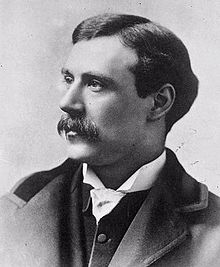William Friese-Greene
| William Friese-Greene | |
|---|---|
 |
|
| Born |
7 September 1855 Bristol, England |
| Died |
5 May 1921 (aged 65) London, England |
| Resting place | Highgate Cemetery |
| Residence | Cliff Road, Dovercourt, Harwich (1897 to 1904) |
| Occupation | Photographer |
| Known for | Motion pictures |
William Friese-Greene (born William Edward Green, 7 September 1855 – 5 May 1921) was an English portrait photographer and prolific inventor. He is principally known as a pioneer in the field of motion pictures, though not the inventor of cinematography; his work post-dates that of Louis Le Prince, who successfully shot the world's first moving pictures in Leeds in 1888.
William Edward Green was born on 7 September 1855, in Bristol. He was educated there at Queen Elizabeth's Hospital. In 1869 he became an apprentice to a photographer named Maurice Guttenberg. By 1875 he had set up his own studios in Bath and Bristol, and later expanded his business with two more studios in London and Brighton. He married Helena Friese on 24 March 1874, and decided to modify his name to include her maiden name.
In Bath he came into contact with John Arthur Roebuck Rudge. Rudge was a maker of a number of instruments but had begun to specialise in the creation of magic lanterns. He had recently developed the 'Biophantic Lantern'. The lantern was unique in that it could display seven slides in rapid succession, and produce an effective illusion of movement. Friese-Greene was fascinated by the machine and in 1886 he began work with Rudge on enhancing it in order to project photographic plates. They called the device a 'Biophantascope'. Friese-Greene realised that glass plates would never be a practical medium for true moving pictures and in 1885 he began to experiment with oiled paper and by 1887 was experimenting with celluloid as a medium for motion picture cameras.
On 21 June 1889, Friese-Greene was issued patent no. 10131 for his 'chronophotographic' camera. It was apparently capable of taking up to ten photographs per second using perforated celluloid film. A report on the camera was published in the British Photographic News on 28 February 1890. On 18 March, Friese-Greene sent a clipping of the story to Thomas Edison, whose laboratory had been developing a motion picture system known as the Kinetoscope. The report was reprinted in Scientific American on 19 April. Friese-Greene gave a public demonstration in 1890 but the low frame rate combined with the device's apparent unreliability made an unfavourable impression. In the early 1890s he experimented with cameras to create stereoscopic moving images but met with limited success. Friese-Greene’s experiments in the field of motion pictures were at the expense of his other business interests and in 1891 he was declared bankrupt. To cover his debts he sold the rights to the 'chronophotographic' camera patent for £500. The renewal fee was never paid and the patent eventually lapsed.
...
Wikipedia
